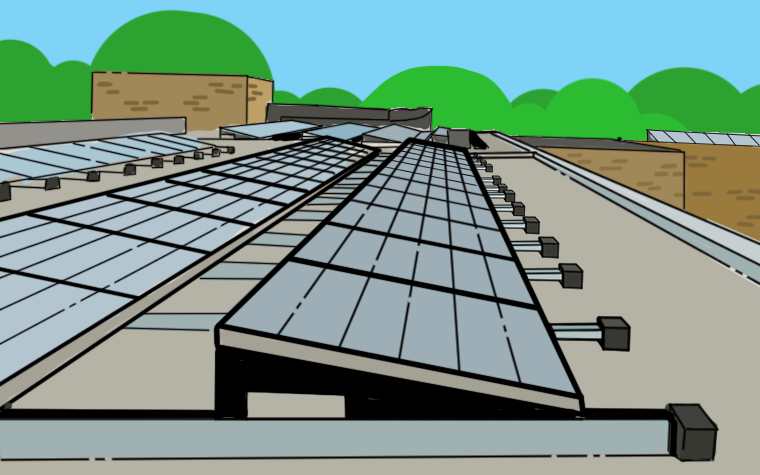Solar panels for schools: are they worth the money?
With government support for energy bills reducing from April 2023, many schools are looking for ways to cut their energy…

With government support for energy bills reducing from April 2023, many schools are looking for ways to cut their energy bills.
We recently published a blog with some ideas for schools to consume less energy, but what if a longer-term solution is required? Solar panels could be the answer.
In this article, we’ll explore the benefits of solar panels for schools and take a look at some schools that are making (or have made) the switch to solar power.
What are solar panels and how do they work?
Solar electricity panels, also known as photovoltaics (PV), capture the sun’s energy and convert it into renewable electricity that you can use to power your school.
They are made up of several solar cells (usually silicon), which are connected together to form each panel.
Solar panels work by absorbing the sun’s light and creating an electric field which causes an electric current to flow. This current is then collected by wires on the backs of the panels and sent to an inverter to convert it from direct current to alternating current electricity that can be used by the school.
There is a standard process for installing solar panels, and it can take several weeks:
- Site survey: Before installing solar panels, it’s important to assess the school’s roof to check that it’s suitable for solar power generation. A site survey will look at things like the orientation of the roof, shading, and the strength of the roof structure.
- Design: The next step is to design a solar panel system that is tailored to the specific requirements of the building. This will include the number and type of solar panels required, as well as additional components like an inverter and battery storage system.
- Installation: The solar panels are then installed on the roof using mounting brackets. The panels are wired together and connected to the inverter.
- Commissioning: Once the solar panels are installed, they need to be connected to the grid and commissioned. This involves testing the system to ensure it’s working correctly and complying with all safety regulations.
What are the benefits of solar panels for schools?
Solar panels are a big investment – of both time and money – so it’s important to understand the benefits they can bring to your school.
-
Cost-savings
Before the energy crisis, solar panels could take as long as ten years to pay for themselves, but the persistently high cost of energy has now reduced that timescale. If future energy prices stay at a similar level to today’s, solar panels could pay for themselves in as little as five years.
Plus, if you lease your solar panels, rather than buy them outright, you can make the investment without any capital outlay at all. This could free up precious funds to invest in other areas of your school.
-
Green energy
Solar panels provide a green source of energy. By generating your own energy via solar panels, your school can reduce its reliance on fossil fuels. This is particularly important for schools with targets around carbon emissions and sustainability.
Schools that have made the switch to solar energy
A number of schools have either made the switch to solar power or are in the process of doing so. Here are some of them:
- A new low carbon secondary school is due to be built in Sussex. The plan is for the school, in Burgess Hill, to generate its own energy on site without using fossil fuels, producing around 296,000 kWh a year from around 1,000 solar photovoltaic panels.
- Seven Hills Primary School in Leeds is to be decarbonised. The existing fossil fuel systems will be replaced with air source heat pumps and solar panels will be installed to provide a source of renewable energy. The energy efficiency will be further improved through the installation of loft insulation and a building energy management system.
- Aston Lodge Primary School in Sheffield is making the move to renewable energy by installing solar panels, an air source heat pump and a water source heat pump.
- The Leys School in Cambridge has been a long-term champion of renewable energy, having installed solar thermal panels on its Fen House building back in 2008, followed by its Thomson (Science) building in 2012 and the Sports Hall in 2013. This took its total power to 50 kW, and the school intends to add more solar panels to its other buildings in the future.
Solar panels for schools can offer significant long-term cost savings in the long term, as well as promoting sustainability.
How to lease solar panels for your school
Buying solar panels outright can easily run into 6-figures, which is out-of-scope for many schools today.
That’s where we can help. We offer compliant operating leases that enable you to make the switch to renewable energy without eating into your school’s capital.
Please request a free consultation to discuss options for your school to generate its own solar-powered electricity.
Tags
Similar Articles
Conserving energy in schools
Every school in the UK has been affected by the European energy crisis. Combined with rising inflation, the increased cost…
Energy efficiency: how schools can combat global warming
Use energy-efficient equipment to reduce the carbon footprint of your school. From replacing water-guzzling toilets to substituting outdated lighting, make greener changes.



